Quercus lobata
White Oak, Valley Oak, Swamp Oak, Roble Oak and California White Oak.
Quercus lobata is a deciduous white oak tree that can grow to 70'. The fastest of our California Oaks. This native oak has deeply-lobed leaves with no bristles. The coloration is green with a little grey.
It is native to the central valley, valleys of Sierra foothills, and coast ranges of California. Valley oak likes sun and moderate water. These oaks are found in some of the valleys of California ,when the water table was lowered below 70 feet or so, these trees died. (This picture was of one of the last oaks in Riverdale, where there used to be hundreds, if not thousands of huge trees set in a pastoral setting.) They like to be plugged into a water source if possible,(thus the name Swamp oak) but not waterlogged. The water source need not be huge, but it does need to be there. One of our friends put his well next to the biggest one on his property thinking he would strike an artesian well, the well only gave 1 gallon/minute in the winter. All summer it was dry...we need more than the tree does. Deer eat this one when they are hungry. (Aren't they always?) This one is also native on the nursery site in Santa Margarita. Easy to grow, it will grow up into a whip for the first years. Before the canopy starts developing, at first into a vase, then an umbrella.. Valley Oak is a fast tree, with water it can grow to 20' in 5 years, 20 more in the next 5. It will then slow down in height, then begin to fill into a vase-like tree. It may stay in this form growing slowly taller for 100 years. After 20 years your tree should look like a 40-60' elm tree without the elm diseases. A bunch of birds will be hanging around it using the acorns and the limb structure for nests. If you come to the nursery the tree at the gate is a valley oak. The old trees you see in many of central and northern California valleys may be 300-500 years old, or 50, often very hard to tell. They have a tendency to be all the same age as they need a high water table for 5-7 years to establish. We have some that are 1' tall that established during the floods of 1979-1981. They were burnt in the 1979 fire and the 1985 fire but they survived the 83-90 drought. 200 years from now they will be the 70'. Other Valley oaks were not there in a 1957 picture and are now 80 feet tall with moss growing on them, we figured they were 100-200 years old until we saw the picture. There are others in a different picture of the same filed that look the same now as then and are the same size as the young whipper snappers. Valley oaks are probably the most tolerant of weeds or lawn under them. If you plant a young one in a lawn area they will flourish. Do not plant a lawn under an old one though, the tree needs to grow with the lawn, Lawn under old tree, kills old tree, headline reads.
Oaks.
It is native to the central valley, valleys of Sierra foothills, and coast ranges of California. Valley oak likes sun and moderate water. These oaks are found in some of the valleys of California ,when the water table was lowered below 70 feet or so, these trees died. (This picture was of one of the last oaks in Riverdale, where there used to be hundreds, if not thousands of huge trees set in a pastoral setting.) They like to be plugged into a water source if possible,(thus the name Swamp oak) but not waterlogged. The water source need not be huge, but it does need to be there. One of our friends put his well next to the biggest one on his property thinking he would strike an artesian well, the well only gave 1 gallon/minute in the winter. All summer it was dry...we need more than the tree does. Deer eat this one when they are hungry. (Aren't they always?) This one is also native on the nursery site in Santa Margarita. Easy to grow, it will grow up into a whip for the first years. Before the canopy starts developing, at first into a vase, then an umbrella.. Valley Oak is a fast tree, with water it can grow to 20' in 5 years, 20 more in the next 5. It will then slow down in height, then begin to fill into a vase-like tree. It may stay in this form growing slowly taller for 100 years. After 20 years your tree should look like a 40-60' elm tree without the elm diseases. A bunch of birds will be hanging around it using the acorns and the limb structure for nests. If you come to the nursery the tree at the gate is a valley oak. The old trees you see in many of central and northern California valleys may be 300-500 years old, or 50, often very hard to tell. They have a tendency to be all the same age as they need a high water table for 5-7 years to establish. We have some that are 1' tall that established during the floods of 1979-1981. They were burnt in the 1979 fire and the 1985 fire but they survived the 83-90 drought. 200 years from now they will be the 70'. Other Valley oaks were not there in a 1957 picture and are now 80 feet tall with moss growing on them, we figured they were 100-200 years old until we saw the picture. There are others in a different picture of the same filed that look the same now as then and are the same size as the young whipper snappers. Valley oaks are probably the most tolerant of weeds or lawn under them. If you plant a young one in a lawn area they will flourish. Do not plant a lawn under an old one though, the tree needs to grow with the lawn, Lawn under old tree, kills old tree, headline reads.
Oaks.
Quercus lobata tolerates sand, clay and seasonal flooding.
Quercus lobata is great for a bird garden.
Foliage of Quercus lobata has color green-gray and is deciduous.
Flower of Quercus lobata has color na.
Communities for Quercus lobata:Mixed-evergreen Forest, Pinyon-Juniper Woodland, Riparian (rivers & creeks), Southern Oak Woodland and Yellow Pine Forest.
| ph: | 6.00 to 8.00 |
|---|---|
| usda: | 5 to 10 |
| height[m]: | 10.00 to 25.00 |
| width[m]: | 10.00 to 15.00 |
| rainfall[cm]: | 60.00 to 159.00 |

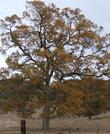
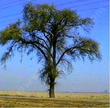

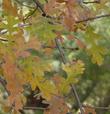
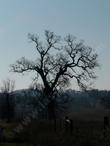
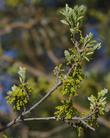
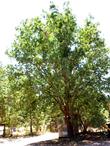 play movie
play movie


